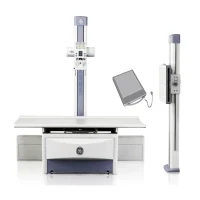
GE Dr-F X-Ray
The GE DR-F is used for capturing high-resolution X-ray images of the body, aiding in the diagnosis and treatment of various medical conditions. It's a part of the digital radiography category, which offers advanced imaging capabilities compared to traditional film-based systems.
Key Features:
- Digital Radiography: Utilizes digital detectors to capture X-ray images, which are then processed and displayed on a computer screen. This allows for immediate image review and reduces the need for physical film.
- High Image Quality: Provides high-resolution images with enhanced clarity and detail, aiding in accurate diagnosis.
- Versatility: Suitable for wide range of imaging applications, including chest, abdominal, orthopaedic, and general radiographic imaging.
- User-Friendly Interface: Typically features an intuitive touchscreen interface for easy operation and image management.
- Efficient Workflow: Integrated with software that facilitates image acquisition, processing, and storage. This often includes features for automated image processing, enhancement, and archiving.
Operation:
- Image Capture: The system uses digital detectors, placed in the X-ray room, to capture images of the body. These detectors convert X-ray energy into digital signals.
- Processing: Images are processed by the system’s software, which can automatically adjust contrast, brightness, and other parameters to enhance image quality.
- Display and Review: Processed images are displayed on high-resolution monitors, allowing radiologists and healthcare providers to review and analyze the results.
Benefits:
- Immediate Results: Digital radiography provides near-instantaneous imaging results, reducing the time needed for diagnosis and treatment.
- Reduced Radiation Exposure: Modern DR systems like the GE DR-F often use lower doses of radiation compared to traditional X-ray systems while still delivering high-quality images.
- Improved Workflow: Digital images can be easily stored, retrieved, and shared electronically, enhancing efficiency and collaboration among healthcare providers.
Maintenance and Support:
- Routine Maintenance: Regular maintenance is essential to ensure the system operates optimally. This includes calibration, software updates, and physical inspections.
- Technical Support: GE Healthcare provides technical support and service options to address any issues that may arise with the system.
